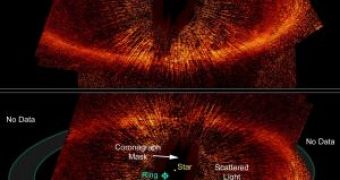The formation of a star is a long process in which dense parts of molecular clouds collapse into a ball of plasma, triggering the birth of the sun. Stellar evolution begins with a giant molecular cloud, also known as a stellar nursery.
Dust clouds surround the young stars and thin out and dissipate as the star reaches maturity, becoming rings in their final stages. Astronomers found a strange-looking star, that doesn't have a ring of matter around, but rather an elliptical one, with the parent star off to one side.
Named Formalhaut, the star has been discovered by a team of astronomers at the University of Rochester, using new images from the Hubble Space Telescope, and it's located 25 light-years away, being the brightest star in the autumn sky.
"We wanted to know why this ring was off-center," says Alice C. Quillen, Associate Professor of Astronomy and author of the study. "People guessed there might be a planet in there, but nobody knew where it might be, or how big it might be. Now we've got a very good idea."
The reason why the ring of matter has a surprisingly sharp edge is the presence of a relatively small, Neptune-size planet, that is tucked right up against the inner side of the ring, using its gravity to toss dust in the area out of orbit.
Another curiosity is the fact that the elliptical shape of the ring must be explained by an elliptical orbit of the Neptunian planet, a strange phenomenon in such a young system, where new planets should, initially at least, orbit in circular paths and not elliptical ones.
This causes the star to be offset by 1.4 billion miles, more than 15 times the distance from the Earth to the Sun. "Something had to skew that planet, and that's what we're working on now," says Quillen. "There may have been fantastic planetary collisions early on that changed their orbits. We're working on figuring out how many more planets of what size you'd need to account for that elliptical orbit, and to account for why there is no other dust inside that ring."

 14 DAY TRIAL //
14 DAY TRIAL //